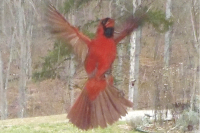Candidates reveal their take on land use plan
Four years ago, the Waynesville town board passed a revolutionary land-use plan that elevated Waynesville to a state example of smart growth principles.
Few could disagree the town’s commercial districts are already looking better as a result: landscaped parking lots, sidewalks, street trees and more attractive buildings. A new super Wal-Mart coming to town will even sport stacked stone columns and a timber-frame gable over the entrance.
But some candidates running for the town board this fall are questioning some elements of the land-use plan. The guidelines are too onerous and deter commercial growth, some candidates say.
This week, we attempted to define for voters where the candidates stand on the town’s land-use plan. During interviews with each candidate, we posed five questions to serve as a litmus test of sorts on the land-use plan.
• The land-use plan requires new businesses to plant trees in their parking lots and a row of trees along the street. Do you agree with this?
• The land-use plan requires new businesses to build a sidewalk along the street frontage of their property. Do you agree with this?
• The land-use plan requires buildings to have architectural interest. Do you think the town should set standards for the design and appearance of new commercial buildings?
• Under the land-use plan, building facades must front the street with parking lots relegated to the side or rear. What do you think about this concept?
• If a developer balked at the town’s rules, how quickly would you be willing to compromise?
Support land-use plan
Candidates that support the land-use plan believe that maintaining the character of the town is a top priority when considering new development. They feel that despite grumbling, new businesses will ultimately comply rather than choose not to come here. Both the business climate and quality of life for town residents will be better off in the long run as a result.
Gavin Brown, a two-term town board member running for mayor this time around, is credited with proposing the idea of a comprehensive, town-wide land-use plan his first month in office eight years ago. The town embarked on a two-year visioning process led by a task force of town residents. Driven by a neighborhood approach, the town sought extensive public input throughout the plan’s creation. The public involvement gave town leaders the political cover to move forward with what were rather revolutionary concepts at the time.
“When you involve the people and let them have a say in the way the town develops, you can’t lose,” said Alderwoman Libba Feichter.
Just a few years ago, not many town candidates would be versed on architectural standards for buildings or debating the appropriate number of trees for parking lots, let alone replacing the center-turn lane on a main commercial drag with a landscaped median. But that’s exactly where things stand today.
“It’s nice to see that people can now visualize what we are talking about,” Brown said.
Mayor Henry Foy has also been a champion of the land-use plan since the early days of its inception.
“Waynesville from WWII on had just been spreading out with no purpose, no plan,” Foy said. “We had to unify it somehow.”
Candidates in this category support making businesses plant trees in their parking lots.
“Aside from the environmental benefits, the plantings just look better,” said LeRoy Roberson, a town board candidate and optometrist with an office on Main Street. “Also they make it safer because people can’t just drive across lanes of parked cars like they can at Wal-Mart. So the trees make it more safe, it looks better, and there’s less runoff.”
Candidates in this category also support architectural standards for buildings. Foy, an architect by trade, said he doesn’t want Waynesville over-run with the same cookie-cutter buildings used by chain stores everywhere else in the country. Instead the town wants something unique.
Brown agreed.
“It gives people a feeling of ‘Hey, I am coming to a town, a place, somewhere I can identify with,’” Brown said.
Roberson said it’s what makes Waynesville unique.
“It just looks good and gives a nice appearance. People don’t come here to look at blank cinderblock walls,” Roberson said.
Perhaps most telling, candidates in this category support the concept of building façades placed close to the street with parking lots to the side or rear. It improves the visual landscape, Foy said. Instead of asphalt parking lots dominating the street landscape, building facades take center stage.
“There’s nothing more boring than a parking lot. How do you differentiate parking lots?” Brown said. “But building design and facades and windows, that creates interest. It provides a semblance of being in a place.”
It also paves the way for better traffic flow. The land-use plan requires neighboring businesses to connect their parking lots. People can hop through the rear parking lots to get from one business to the next, rather than pulling out on the main drag only to drive a few hundred feet before pulling into their next destination.
“Businesses can work together and let people work together and let people pass through their back parking lots,” Foy said.
Most candidates in this category support the requirement that new businesses install sidewalks along their street frontage.
“I have no problem with telling a developer ‘the sidewalks are your expense. You have created the development and we have offered you a community to come to,’” Brown said.
Since the requirement only applies to new businesses, sidewalks are being built in areas where there are no other sidewalks, creating sidewalk islands in front of a single business that lead nowhere. But over time, sidewalks will fill in, even if it takes 100 years, Brown said.
“A board’s job is to ensure that a community is vibrant and alive and existing 100 years from now,” Brown said. “Let’s keep our eye on our vision.”
Roberson had an issue with this one part of the land-use plan, but it wasn’t enough to bump him from the “land-use plan supporter” category. Roberson questioned the expense that a new sidewalk can add, especially for a small business owner. He suggested the town share in the cost.
“I think it is good if you have a plan to say this is a part of what is or what is going to be a walkable community, and that we want these areas connected by sidewalks,” Roberson said. “We don’t need to say ‘if you can’t afford it tough.’ I don’t see why the town can’t help with sidewalks. The town is responsible for sidewalks anyway.”
Supports most of land-use plan
Candidates in this category support most of the guidelines currently required of new commercial development, but are a bit hesitant in some areas. The top qualm that landed candidates in this category was their opposition to building facades, not parking lots, abutting the street. The town’s land-use plan relegates parking lots to the side or rear of the buildings in an attempt to redefine the visual streetscape in commercial districts.
But the rule doesn’t always result in a better appearance. Alderman Gary Caldwell uses two neighboring businesses on Russ Avenue as an a example: one abutting the street and one built further back with its parking lot in front. The one built close to the street — McDonald’s — still looks like a McDonald’s, Caldwell said, just closer to the street.
“To me, it is nothing attractive. It is just a building. There is nothing great about how it looks,” Caldwell said.
His other example: “You look across the street at Home Trust Bank and it’s gorgeous.”
Home Trust Bank has its parking lot in front, but still looks nice, he said. The town should stay tough on landscaping requirements to mitigate the asphalt look of the parking lots and drop the requirement that parking go to the side or rear, Caldwell said
Caldwell supports other elements of the land-use plan: the sidewalks, the trees and the design standards for buildings.
“You don’t want them to throw up something that just looks like a piece of concrete. You want something with architectural design to it,” Caldwell said.
Like the other candidates that landed in this category, Charles Miller also questioned the concept of building facades fronting the street rather than parking lots.
“What bothers me about bringing buildings out to the street is what it eventually might look like. Are you eventually going to have it look like an alleyway?” Miller asked. Miller cited CVS pharmacy on Russ Avenue as an example of a building placed close to the street but not exactly attractive. Miller then pointed to Burger King on Russ Avenue, built prior to the land-use plan, and said “I think it looks great.”
Miller said he’s seen pictures of towns with similar guidelines supposedly copied by Waynesville. The pictures show boulevard-type streets lined with trees, sidewalks and street row of building facades. But Miller wants more than a picture.
“I would like to talk to some of the people who have been involved in smart growth planning in some of these towns and some of the people who live there and see what they think about it,” Miller said. “It’s not that I don’t support it. I would just like to look first hand at somewhere it’s been done on a larger scale than two or three businesses.”
Miller also questioned the town’s sidewalk rule. The town requires new business to build sidewalks along their street frontage, even if there are no other sidewalks in the area.
“Building a 50-foot sidewalk hundreds of yards from an existing sidewalk doesn’t make too much sense to me,” Miller said. “Say you make them do it and it sits there for 50 years before the next section gets built and the first section has crumbled apart by then.”
Miller is also concerned about the cost of sidewalks being too much of a financial burden for small businesses and suggested the town share in the cost.
“I kind of have a problem with who should pay what,” Miller said
Dick Young had the least to say about Waynesville’s land-use plan, mentioning the pros of various elements, promptly followed by the cons, making it difficult to determine where he stood.
He said he supported making businesses build sidewalks, but added that it “could get quite expensive.”
He seemed to support trees in parking lots, as well as design standards for buildings.
But like Caldwell and Miller, he doesn’t support the parking in back.
“My honest feeling on it is that there are a lot of businesses that would want to come to town that would not come because of that,” Young said. Placing buildings close to the street also hems in the street from being widened, Young said.
“They don’t ever want Russ Avenue to be any wider than what it is now. They want to keep it a small town,” Young said.
But Young sees merit in one aspect of parking in back. The back parking lots are being connected between neighboring businesses, forming a sort of rear access road for people to move from one business to another without pulling back out on the main drag.
Don’t like land-use plan
Candidates in this category had several issues with the land-use plan. They believed the plan is too strict, overly burdensome from a financial standpoint and is driving away new businesses.
Alderman Kenneth Moore voted for the land-use plan four years ago, but now thinks it is too strict.
“It seems every other meeting there are a bunch of amendments,” Moore said. “Somebody will bring in their plans and it don’t work with our land-use plan. Some of the contractors are dissatisfied. I’ve heard them say they can do anything out in the county but when they get into Waynesville, they say there is too strict a rule on it.”
Moore would be willing to “lighten up” the requirements for trees in parking lots. He doesn’t think every business should have to build a sidewalk.
“There are places where it don’t make sense to me, just putting a little slab of concrete out there in front of your business,” Moore said.
He also doesn’t support architectural design standards for buildings.
“I think a business when they come in they should have the right to build their building the way they want to and do their parking the way they want to and not make them do what we want them to do,” Moore said. “We need a little leniency and compromise with some of these people.”
Moore thinks the town should have compromised more with the new Super Wal-Mart coming to town, even though it didn’t deter them from coming here.
“I think they should have been more liberal and let Wal-Mart do their own thing,” Moore said. “I think we should lift some of these really.”
Also displeased with the land-use plan is candidate Russell “Ty” McLean. In fact, it’s one of McLean’s top platforms.
McLean particularly opposes the concept of forcing building facades up to the street and relegating parking lots to the side or rear of buildings. McLean pointed to CVS pharmacy on Russ Avenue as an example of a building that complied with that rule, but didn’t in turn make it any more aesthetically pleasing.
“I can’t think of one person I’ve talked to that thinks that CVS is an attractive building,” McLean said. McLean wants to let businesses put their parking lots in front but mitigate the asphalt look with great landscaping.
McLean said the goal seems to be to convert Russ Avenue into a Main Street type environment, but that it will never happen, not even in 50 years. Placing buildings close to the street limits the ability to widen roads in the future. Also, businesses can’t use the vehicle traffic in their parking lot as advertisement.
“Customers migrate to places that seem to be doing a good business,” McLean said. “If you hide the vehicle traffic behind the businesses, that hurts the businesses.”
McLean supports the requirements for trees in parking lots and street trees. He supports architectural standards for buildings — to a certain extent.
“I think certain limited architectural standards are beneficial. Architectural standards that raise building costs unnecessarily are bad,” McLean said. McLean would like to see a different set of criteria for corporate chains versus small businesses.
“These big, large, national chains have the money to do that. However, your average small business owner doesn’t have or may not have the money to do it the town’s design standards,” McLean said.
Hugh Phillips, a candidate for mayor, supports little about the town’s land-use plan. He prefers parking lots in front of buildings and doesn’t like it when facades are too close to the street.
“I’m not fond of it. I don’t like the way it looks,” Phillips said. “It looks like you are driving down the backside of a town.”
He also doesn’t like architectural building design standards that would make the town look too uniform. Phillips said he saw a photograph of a town Waynesville is trying to copy.
“It is just blah. It’s all the same brick. They all have the trees and sidewalks,” Phillips said.
He said McDonald’s should look like a McDonald’s, but the new one on Russ Avenue doesn’t. If you weren’t looking for it, you might not even notice it, he said.
Phillips is hesitant about requiring trees and sidewalks, fearing some businesses might not be able to afford it.
“I think trees are nice. Don’t get me wrong, I’m all for trees. But some businesses are really small and they have nowhere to put a tree,” Phillips said.
Phillips also questioned whether Ingles on Russ Avenue should have to plant trees in its parking lot as part of an expansion. The tree guidelines will only apply to the portion of the parking lot in front of the expansion — not the whole parking lot. Phillips thinks it would look funny to have trees in only part of the parking lot and therefore wouldn’t make Ingles plant any at all.
Bernie Branhut, a candidate for mayor, thinks the town should compromise more, whether it’s over trees in parking lots or sidewalks. Branhut was afraid the town would drive off a new Wal-Mart with its insistence over trees in the parking lot, although in the end Wal-Mart is planting the trees.
Branhut questioned the carte blanche requirement that new businesses build sidewalks along their street frontage.
“It is according to the location,” Branhut said. He said it was stupid to make the new Harley Davidson dealer located by a highway exit ramp build a sidewalk.
“Why do they need a sidewalk? They don’t need a sidewalk. There’s nobody that walks out there,” Branhut said. “People have been bombarded with regulations obstructing their growth.”
Whenever Branhut was unsure of his position on a certain element of the land-use plan, he gave the same answer: “Get public input. Have a referendum and vote on it.”









